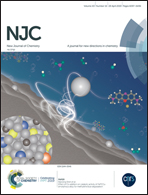Preparation of N-doped yellow carbon dots and N, P co-doped red carbon dots for bioimaging and photodynamic therapy of tumors†
Abstract
Red emissive carbon dots (CDs) have attracted more and more attention in biological fields, due to less interference from autofluorescence of the biological matrix and lower photodamage to biological tissues. Herein, N and P co-doped red emissive carbon dots (R-CDs) were firstly prepared with o-phenylenediamine and phosphoric acid as the raw materials using a facile hydrothermal method. The R-CDs exhibited excitation-independent emission peaks at 622 nm with an absolute fluorescence quantum yield (QY) of 15% in water. At the same time, N-doped yellow emissive carbon dots (Y-CDs) were also synthesized with o-phenylenediamine using a similar procedure to that used for the R-CDs. Both CDs were successfully applied to in vitro cell imaging. By comparing the optical properties and surface states of the Y-CDs and R-CDs, we concluded that the photoluminescence (PL) of the CDs is related to the surface states of both CDs, and the surface functional group C![[double bond, length as m-dash]](https://www.rsc.org/images/entities/char_e001.gif) O plays the main role in the yellow emission, while the new surface state introduced by doping phosphorus atoms into the R-CDs is responsible for the red emission. More importantly, the R-CDs had an excellent capability for killing cancer cells and inhibited the growth of a tumor under 532 nm laser irradiation. This work provides a novel strategy for preparing red emissive CDs and expands the application of CDs in biological fields.
O plays the main role in the yellow emission, while the new surface state introduced by doping phosphorus atoms into the R-CDs is responsible for the red emission. More importantly, the R-CDs had an excellent capability for killing cancer cells and inhibited the growth of a tumor under 532 nm laser irradiation. This work provides a novel strategy for preparing red emissive CDs and expands the application of CDs in biological fields.



 Please wait while we load your content...
Please wait while we load your content...